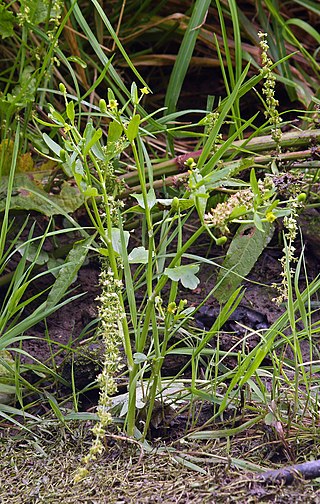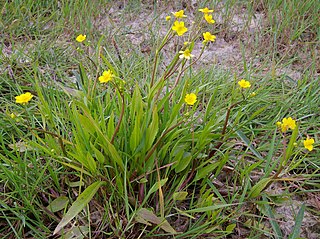
Ranunculus is a large genus of about 1750 species of flowering plants in the family Ranunculaceae. Members of the genus are known as buttercups, spearworts and water crowfoots.

Ranunculus repens, the creeping buttercup, is a flowering plant in the buttercup family Ranunculaceae, native to Europe, Asia and northwestern Africa. It is also called creeping crowfoot and sitfast.
There are over 190 vascular plant species on the Norwegian Arctic archipelago of Svalbard. This figure does not include algae, mosses, and lichens, which are non-vascular plants. For an island so far north, this number of species constitutes an astonishing variety of plant life. Because of the harsh climate and the short growing season, all the plants are slow growing. They seldom grow higher than 10 cm (4 in)

Ranunculus glacialis, the glacier buttercup or glacier crowfoot, is a plant of the family Ranunculaceae. It is a 5-10(-20) cm high perennial herb. Often with a single relatively large flower, with 5 petals first white later pink or reddish. The underside of the 5 sepals are densely brown-hairy. The leaves are fleshy, shiny, and deeply loped, forming 3 leaflets. Ranunculus glacialis is reported to have a diploid chromosome number of 2n = 16.

Ranunculus bulbosus, commonly known as bulbous buttercup or St. Anthony's turnip, is a perennial flowering plant in the buttercup family Ranunculaceae. It has bright yellow flowers, and deeply divided, three-lobed long-petioled basal leaves.

Ranunculus acris is a species of flowering plant in the family Ranunculaceae, and is one of the more common buttercups across Europe and temperate Eurasia. Common names include meadow buttercup, tall buttercup, common buttercup and giant buttercup.

Ranunculus sceleratus known by the common names celery-leaved buttercup, celery-leaf buttercup, and cursed buttercup is a species of flowering plant in the buttercup family Ranunculaceae. It has a circumpolar distribution in the northern hemisphere, native to temperate and boreal North America and Eurasia, where it grows in wet and moist habitats, including ponds and streambanks.

Ranunculus arvensis, the corn buttercup or field buttercup, is a plant species in the family Ranunculaceae. Native to Europe, it can be found on other continents as an introduced species and sometimes a weed, including in North America and Australia. It was formerly a common annual arable weed in Britain, but is now rare there. It is most often found in moist places, such as spring puddles in meadows.

Ranunculus flammula, the lesser spearwort, greater creeping spearwort or banewort, is a species of perennial herbaceous plants in the genus Ranunculus (buttercup), growing in damp places throughout the Boreal Kingdom. It flowers June/July. Ranunculus flammula is poisonous. It is very closely related to R. reptans, which is distinguished by prostrate and more slender stems, narrower leaves and smaller flowers and is sometimes included within R. flammula sensu lato as a variety.

Ranunculus papulentus, commonly known as the large river buttercup, is a buttercup that is endemic to south-eastern Australia.

Ranunculus sardous is a species of buttercup known by the common name hairy buttercup. It is native to Europe and it can be found in many other areas of the world, including parts of the United States and Australia, as an introduced species and a roadside and lawn weed. It grows in many types of disturbed habitat, especially in moist areas. It is an annual or biennial herb producing a mostly erect, hairy stem up to half a meter tall. The hairy leaves are usually divided into three leaflets which are borne on petioles a few centimeters in length. The flower has usually five yellow petals each up to a centimeter long and five reflexed sepals. The fruit is an achene borne in a spherical cluster of up to 35.
Ranunculus crassipes is a small flowering plant in the buttercup or crowfoot family Ranunculaceae that is native to the subantarctic region. The specific epithet comes from the Latin and refers to the plant's thicker and more succulent form compared to the closely related R. biternatus.

Ranunculus auricomus, known as goldilocks buttercup or Greenland buttercup, is a perennial species of buttercup native to Eurasia. It is a calcicole typically found in moist woods and at the margins of woods. It is apomictic, and several hundred agamospecies have been recognised.

Ranunculus lappaceus, commonly known as the common buttercup, Australian buttercup or Yarrakalgamba, is found across eastern Australia. Like buttercups elsewhere, it is a perennial herb with yellow flowers appearing in spring and summer.
Mount Wellington is a mountain located to the north-east of Licola in Victoria, Australia. It is on the border of the Alpine National Park and Avon Wilderness Park. The Avon River rises on its south-eastern slopes.

Ranunculus acaulis, in Australia and New Zealand called dune buttercup, sand buttercup or shore buttercup, is a yellow-flowered, small, fleshy herb, that grows in mats in damp places mostly near the sea. It occurs naturally in Australia, New Zealand, Chile and the Falklands. It flowers between August and April and sets seed from September till July.

Ranunculus anemoneus, commonly known as the anemone buttercup, is an endangered species of buttercup found in alpine Australia.

Ranunculus amphitrichus commonly known as the small river buttercup, is a flowering plant in the family Ranunculaceae. It has glossy green leaves, daisy-like yellow flowers and grows in Western Australia, southeastern Australia and New Zealand.

Ranunculus inundatus, commonly known as the river buttercup, is a species of buttercup found in eastern Australia. The plant has found some recent relevance within the freshwater aquascaping and home aquarium/vivarium hobbies, particularly amongst enthusiasts of nano aquariums.
















